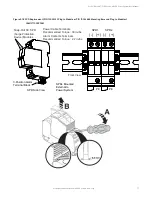
Vertiv™ NetSure™ 5100 Series -48 VDC Power System User Manual
Proprietary and Confidential © 2022 Vertiv Group Corp.
56
Replacing an SM-DU Circuit Card in a List 60 Hybrid Connection Cabinet
Procedure
NOTE!
Refer to Figure 5.12
as this procedure is performed.
1.
Performing this procedure may activate external alarms. Do one of the following. If possible, disable these alarms. If these
alarms cannot be easily disabled, notify the appropriate personnel to disregard any future alarms associated with this system
while the procedure is being performed.
DANGER!
Performing the next steps exposes service personnel to battery potential. Exercise extreme caution not to
inadvertently contact or have any tool inadvertently contact any energized electrical termination.
WARNING!
Damage to the circuit card may result if the next step is not followed.
2.
Connect an approved grounding strap to your wrist. Attach the other end to a suitable ground.
3.
Remove the rear covers to access the circuit card mounting screws. See Figure 5.12.
4.
Unplug all connectors plugged into the circuit card.
5.
Remove the screws securing the circuit card and remove the circuit card from the cabinet.
6.
In this step, ensure you do not intermix the old and replacement circuit cards. Set the switches on the replacement circuit
card to the same setting as the old circuit card. Switch settings are documented in the “Setting Jumper and Switch Options”
section of the Power System Installation Instructions (IM582137100).
7.
Orient the replacement circuit card over its mounting position inside the cabinet, and secure with the screws removed from
the old circuit card.
8.
Plug all connectors removed from the old circuit card into the same position on the replacement circuit card.
9.
Reinstall the rear covers.
10.
Remove the grounding wrist strap.
11.
Temporarily remove then re-insert the controller. Wait for the controller to initialize.
12.
Enable the external alarms, or notify appropriate personnel that this procedure is finished.
13.
Ensure that there are no local or remote alarms active on the system.
















































